Correct means safe: methods for connecting bimetallic heating radiators
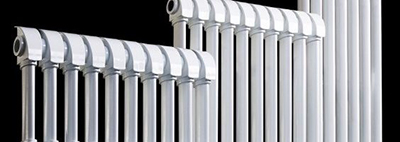
Bimetallic radiators are devices, consisting of two materials. Typically it is an alloy of aluminum and steel, although other options are available.
Such batteries are in high demand due to the combination of good characteristics.
The process of preparation for connection from the boiler
Preliminary work is very important before installing heating radiators:
- Inspection of the current harness. The study will allow the creation of a similar system, which will have a positive impact on operation.
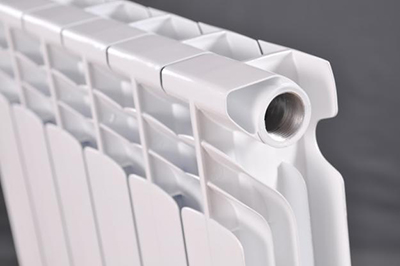
- Checking radiator components. The kit must include: Mayevsky tap, shut-off valves, brackets.
Some models include adapters and a gasket, sometimes you need to buy them separately. When replacing manually, you will need tools - keys that are suitable in size. And you also need to buy a sealant.
- Checking the pipes for compatibility with the new battery. The outer layer of the bimetallic device is made of aluminum, which does not combine with soft materials. For example, it will be necessary to replace the copper piping or taps. Otherwise, the system is at risk of rapid destruction.
- Selecting a location for the battery. This is especially true for fasteners if you are replacing an old device.
- Conducting a radiator inspection for visible damage, integrity of the surface, coating.

- If the components are fully compatible, they begin replacement. At the preparatory stage, water is drained from the old batteries.
Having completed the preparation, they proceed to the selection of the connection scheme. The first point states that you should choose an option similar to the old one. This will allow do not rebuild the entire system and maintain the current efficiency. The operating process is quite simple and is described below.
Important! At the end they carry out test complex, known as pressure testing. It involves testing with water, heat and pneumatics.
Connection methods and diagrams
Exists three installation methods radiators:
- Side: the feed is connected to the top of the battery, and the return to the bottom, and on one side. This option is effective if the number of sections does not exceed 10. Otherwise, the remote part will heat up weakly, which will reduce the efficiency. This type of connection scheme is most common in apartment buildings.
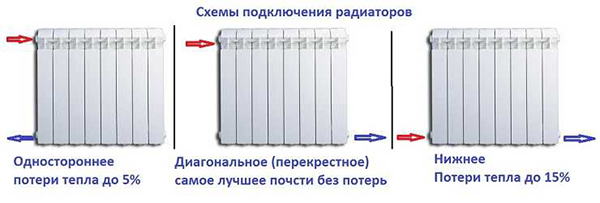
Photo 1. Three common connection schemes for bimetallic heating radiators and their approximate heat losses.
- Lower: Both pipes are connected from one end, horizontally, which helps to hide the piping and create a beautiful interior. It is used in well-heated rooms or in combination with heated floors. This is due to the weak heating of the radiators, through which the water must rise upward.
- Diagonal: The feed is mounted to the top of the battery, and the return to the bottom, but on the other side. The coolant easily spreads throughout the entire volume, which makes this scheme the most effective.
When installing a new device in an apartment building, you need to choose the same option that was conceived by engineers. In a private building, you should focus on to personal preferences and calculations.
How to properly connect a bimetallic heating radiator in an apartment
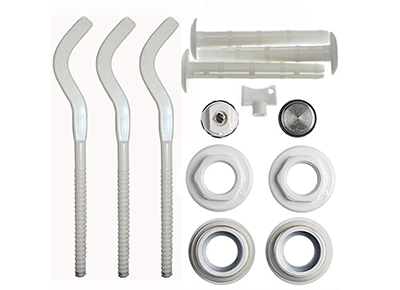
Having decided on the scheme, prepare the parts:
- battery;
- pipes;
- taps;
- air release valve;
- adapters;
- shut-off valves;
- brackets;
- gaskets.
Reference! Most of the parts are OK complete with radiator. If some components are missing, they must be purchased additionally.
The process itself consists of in 6 steps:
- Dismantling the old device. It begins at the preparatory stage with draining the water from the current battery. To do this, close the valve on the feed and open it on the return. Then, remove the sections of pipes adjacent to the main line. Usually, they are simply unscrewed. If the connections do not have threads, use heating devices.
- Marking the battery mounting points. To do this, the radiator is applied to the intended installation location. You will need at least two people: While one holds, the other marks with a pencil (or other object, depending on the coating). It should be remembered that the pipes must be joined, and a building level must be used for alignment.
- Installation and fixing of fasteners. At the designated points, holes are made for the fasteners. This will require a hammer drill and dowels. The latter are often included in the kit.
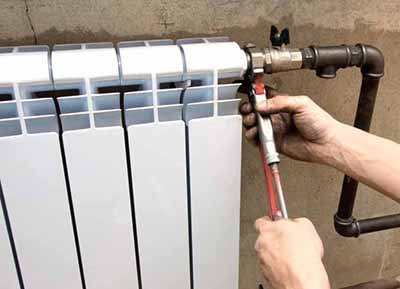
For radiators from three sections one mount is enough, from 4–6 – two, from 7–9 – three, in other cases – four.
Five or more are required when installing very long structures, the use of which is impractical due to reduced efficiency.
- Installing a radiator. The device is placed on the fasteners so that the horizontal manifold is suspended. It should be taken into account that bimetallic radiators must be connected and tested in the factory packaging. This helps when detecting problems: after an unsuccessful crimping, the battery is easily dismantled and returned to the manufacturer for troubleshooting or replacement with a new one. The working device is fixed by screwing it into the thread. Sometimes the pipes are simply welded, which depends on the specific piping.
- Installation of the Mayevsky crane. The device is always included in the radiator kit. It is placed in any accessible point of the battery for maintenance, tightening with a torque wrench. This method of fastening will help to avoid exceeding the voltage above the norm. Then, the shut-off valves and temperature regulator are installed, if the latter is used.
- Connection to a heat-conducting heating system. Bimetallic radiators cannot be cleaned with sandpaper or files, as this will damage the casing. This will lead to leaks, which in rare cases will develop into a breakthrough.
Features of connecting batteries in a private house
During installation it is necessary observe the principles described above. Sequential placement of components and careful control over the process will allow you to create a system that can operate for a long time from the boiler without additional maintenance.
Important! When choosing a location, you should choose areas with easy access. This will make possible repairs more convenient. And also will make it easier to turn off the taps if pressure testing is necessary.
In principle the schemes are no different from those used in apartments. Installing a bimetallic radiator is quite simple, but to ensure accuracy it would be right to invite a specialist.
Useful video
After watching the video, you can familiarize yourself with the process of piping, soldering pipes, and installing the radiator itself.
The importance of quality work
High quality installation - the basis for long-term operation. Mistakes made during the work process can lead to failure. First of all, this concerns taps, welding, gaskets and sealed joints.





